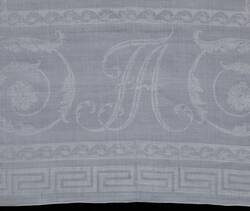Further Media
This precious and well-preserved textile is a damask napkin. Such accoutrements were integral to the table culture of the upper classes. Thanks to the year embroidered in the lower left corner, it can be dated to 1804. It was the reign of Elector Frederick Augustus III, whose monogram - F.A. - is woven into the edge. It was during his long reign that Classicism took hold in Saxony, as this napkin attests. His coat of arms - the crossed Electoral swords and the crancelin, with the Electoral hat above - can be found in the centre.
The composition is dominated, however, by the rich framing. The foliage bordering the coat of arms is reminiscent of the frieze type known as Vitruvian scroll, which has been used since Antiquity and again during the Classicist period. Delicate volutes of acanthus leaves wind around this leaf border, forming floral wreaths at the corners and in the centre. This is followed by another leaf border, which in turn is framed by a meander frieze.
This napkin was made in Großschönau, a small town near Zittau in Upper Lusatia, which was a centre of damask production from the middle of the seventeenth century. The luxury goods produced from linen and silk on the looms there were popular far beyond the country’s borders, comparable to the vogue for porcelain from Meissen. The name of the fabric is derived from the Syrian city of Damascus and is characterised by the alternation of warp- and weft-faced sections, which - as in the case of the present napkin - allowed for both figurative and decorative ornaments.
Text: Alexander Röstel
